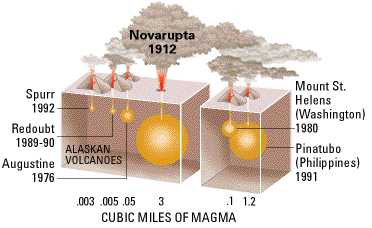
The relative size of the Novarupta eruption compared to other volcanoes on the basis of cubic miles of magma ejected. Novarupta was rated VEI 6 on the volcanic explosivity index. USGS Image.
Posted on 06/07/2017 10:44:30 AM PDT by JimSEA
June 6th, 1912
The morning of June 6th arrived on the Alaska peninsula to find the area which is now Katmai National Monument being shaken by numerous strong, shallow earthquakes. The most powerful volcanic eruption of the 20th Century was about to begin – but very few people knew about it. The Alaska peninsula has a low population density today, but in 1912 it was even lower. Beyond the land shaken by the earthquake activity, the beginnings of this event were almost unnoticed. On June 6th, 1912, a tremendous blast sent a large cloud of ash skyward, and the eruption of the century was underway. People in Juneau, Alaska, about 750 miles from the volcano, heard the sound of the blast – over one hour after it occurred.
For the next 60 hours, the eruption sent tall dark columns of tephra and gas high into the atmosphere. By the time the eruption ended the surrounding land was devastated, and about 30 cubic kilometers of ejecta blanketed the entire region. This is more ejecta than all of the other historic Alaska eruptions combined. It was also thirty times more than the 1980 eruption of Mount St. Helens, and three times more than the 1991 eruption of Mount Pinatubo, the second-largest in the 20th Century. Novarupta topo map Novarupta topo map: USGS Topographic Map of the Novarupta/Katmai Area by MyTopo.com. Click to Enlarge.
Impact of the Eruption The inhabitants of Kodiak, Alaska, on Kodiak Island, about 100 miles away, were among the first people to realize the severity of this eruption. The noise from the blast would have commanded their attention, and the visual impact of seeing an ash cloud rise quickly to an elevation of 20 miles then drift towards them would have been terrifying.
Within just a few hours after the eruption, a thick blanket of ash began falling upon the town - and ash continued falling for the next three days, covering the town up to one foot deep. The residents of Kodiak were forced to take shelter indoors. Many buildings collapsed from the weight of heavy ash on their roofs.
Outside, the ash made breathing difficult, stuck to moist eyes, and completely blocked the light of the sun at midday. Any animal or person who was caught outside probably died from suffocation, blindness, or an inability to find food and water.

The relative size of the Novarupta eruption compared to other volcanoes on the basis of cubic miles of magma ejected. Novarupta was rated VEI 6 on the volcanic explosivity index. USGS Image.
Interesting find, thanks for posting it.
It was the Katmai vent in the Novarupta volcano that erupted. Katmai is one of 5 vents of the Novaurupta complex.
Early investigators assumed that Katmai was responsible for the eruption. This assumption was based upon Katmai being near the center of the impact area, Katmai was visibly reduced in height, and early witness accounts thought that the eruption cloud ascended from the Katmai area. Closer observation was not possible, and expeditions into the impact zone would be very difficult to accomplish.
The first scientific investigation to get an up-close look at the eruption area did not occur until 1916 when Robert Griggs found a 2-mile-wide caldera where Mount Katmai once stood. He also found a lava dome at the Novarupta vent. These observations convinced Griggs that Katmai was the source of the eruption.
It was not until the 1950s - over forty years after the eruption - that investigators finally realized that ash and pyroclastic flow thicknesses were greatest in the Novarupta area. This discovery produced a revelation that Novarupta - and not Katmai - was the volcano responsible for the eruption
Disclaimer: Opinions posted on Free Republic are those of the individual posters and do not necessarily represent the opinion of Free Republic or its management. All materials posted herein are protected by copyright law and the exemption for fair use of copyrighted works.